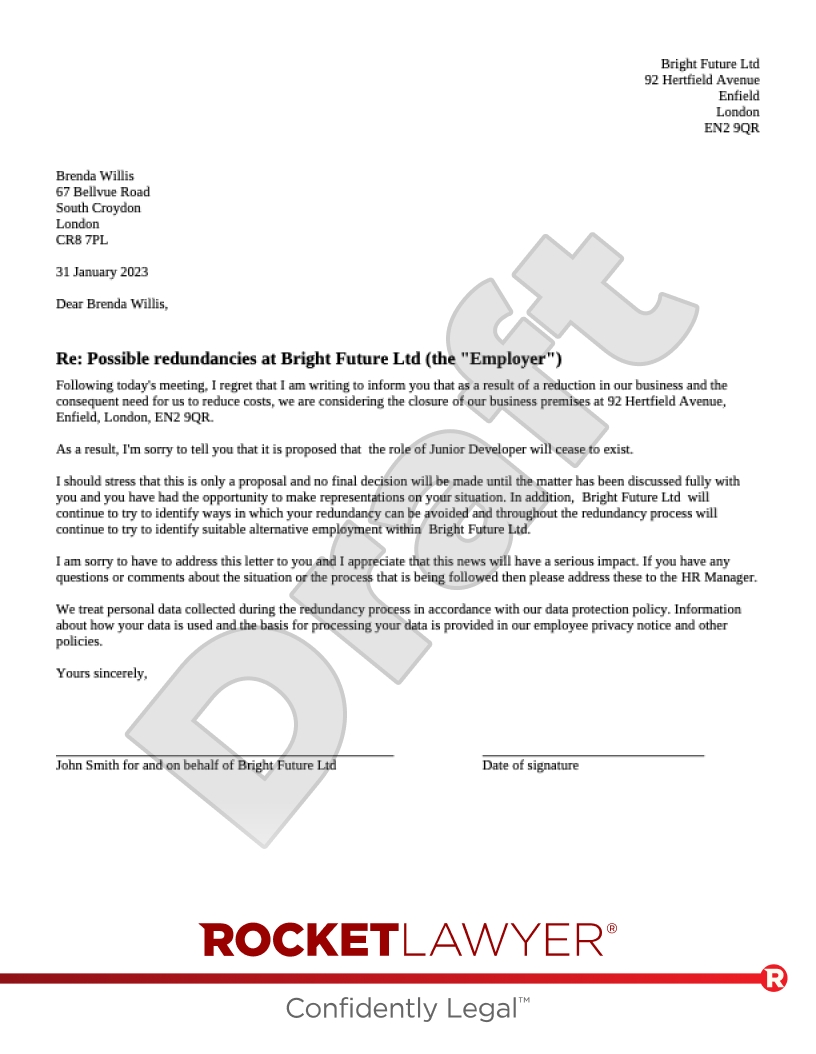What is redundancy?
Redundancy is one of the potentially fair reasons to dismiss an employee. It has a strict legal meaning and only applies where an employer:
-
stops carrying on the business for which a particular employee was employed, either completely or in the place where the employee works
-
stops requiring employees or requires fewer employees to carry out work of a particular type, either at all or in the place where the employee works
It is not redundancy if you want to dismiss someone on performance grounds or simply feel they are not right for the role.
If your business is a small or micro business (eg it has between 1 and 50 employees with a turnover below £10 million), the redundancy process is different. For more information, read How to make someone redundant in a small business.
What process must be followed in a redundancy situation?
Try to avoid or reduce redundancies by considering alternatives like recruitment or pay freezes, bans on agency staff or contractors and changing contract terms.
Warn all potentially affected staff of the risk of redundancy at an early stage in the process. This is especially important where you need to select between employees in similar roles. Consider using an At risk of redundancy letter for this purpose.
Each affected employee must be consulted about their possible redundancy before the final decision. The meeting should be in private and with a view of reaching an agreement. Consider using a Redundancy consultation letter to inform employees of the date and time of a meeting to discuss potential redundancies. This letter can be the first step in your redundancy process if you are just making one employee in a unique role redundant and there is no element of selection.
Choose staff for redundancy carefully, fairly and rationally. This can be tricky to get right so, for more information, read Redundancy pooling and selection. Note that you will need to take extra care when making redundancies that involve employees who are pregnant; who are on maternity leave, adoption leave, or shared parental leave; or who have recently returned from one of these types of leave. For more information, read Redundancy protection during and following pregnancy and family leave.
You should also make any reasonable adjustments that are necessary to enable any employees with disabilities to participate fully in a redundancy process. What is considered reasonable will depend on the specific circumstances of a given redundancy process. For more information, read Disability and reasonable adjustments.
Consider any suitable alternative employment that might be available within your business (or a parent company if there is one), even if additional training may be needed. Keep considering this right up until the dismissal takes effect (ie during the notice period, after redundancy is confirmed).
Give employees the right to appeal their selection for redundancy. Consider using a Letter inviting an employee to a redundancy appeal meeting for this purpose.
Take care to abide by all the dismissal basics relating to issues such as notice period and accrued holiday pay and remember that redundant employees have the right to time off to look for alternative employment. Consider using a professionally prepared Redundancy dismissal letter.
What else should I know about redundancy?
Employees who are dismissed on grounds of redundancy after at least two years' service are entitled to a statutory redundancy payment according to their pay, age and length of service (capped at 20 years).
Statutory redundancy payments (SRPs) are calculated by multiplying a week's pay (capped at a statutory limit) as follows:
-
0.5 week's pay for each full year of service while they were under 22
-
1 week's pay for each full year of service while they were 22 or older, but under 41
-
1.5 weeks' pay for each full year of service while they were 41 or older
Many employers choose to make enhanced redundancy payments but make sure that you do not unlawfully discriminate. The safest method is to use the structure of the statutory formula with a slight change (ie multiply the SRP by a factor or multiply the number of weeks' pay by the same factor for each age group or use actual weekly pay instead of the statutory limit).
Employers often make payment of enhanced redundancy pay conditional on the signature of a Settlement agreement to waive any claims.
Special additional rules apply where it is likely that 20 or more employees will be redundant and you should Ask a lawyer to do this.
When following the redundancy procedure, remember to follow any data protection policies and notices. You should tell employees the types of data you might collect about them and what you do with it in an Employee privacy notice (also known as a 'fair processing statement') - a statement describing how you collect, use, retain and disclose personal information. For more information, read Data protection and employees.
Help with redundancy - Scotland only
If you are facing redundancy or have recently been made redundant, you can access help and support through Partnership Action for Continuous Employment (PACE). PACE is a Scottish initiative that helps and assists individuals and employers by offering advice and support regarding redundancy. To find out how to access PACE, please visit Redundancy Scotland.




